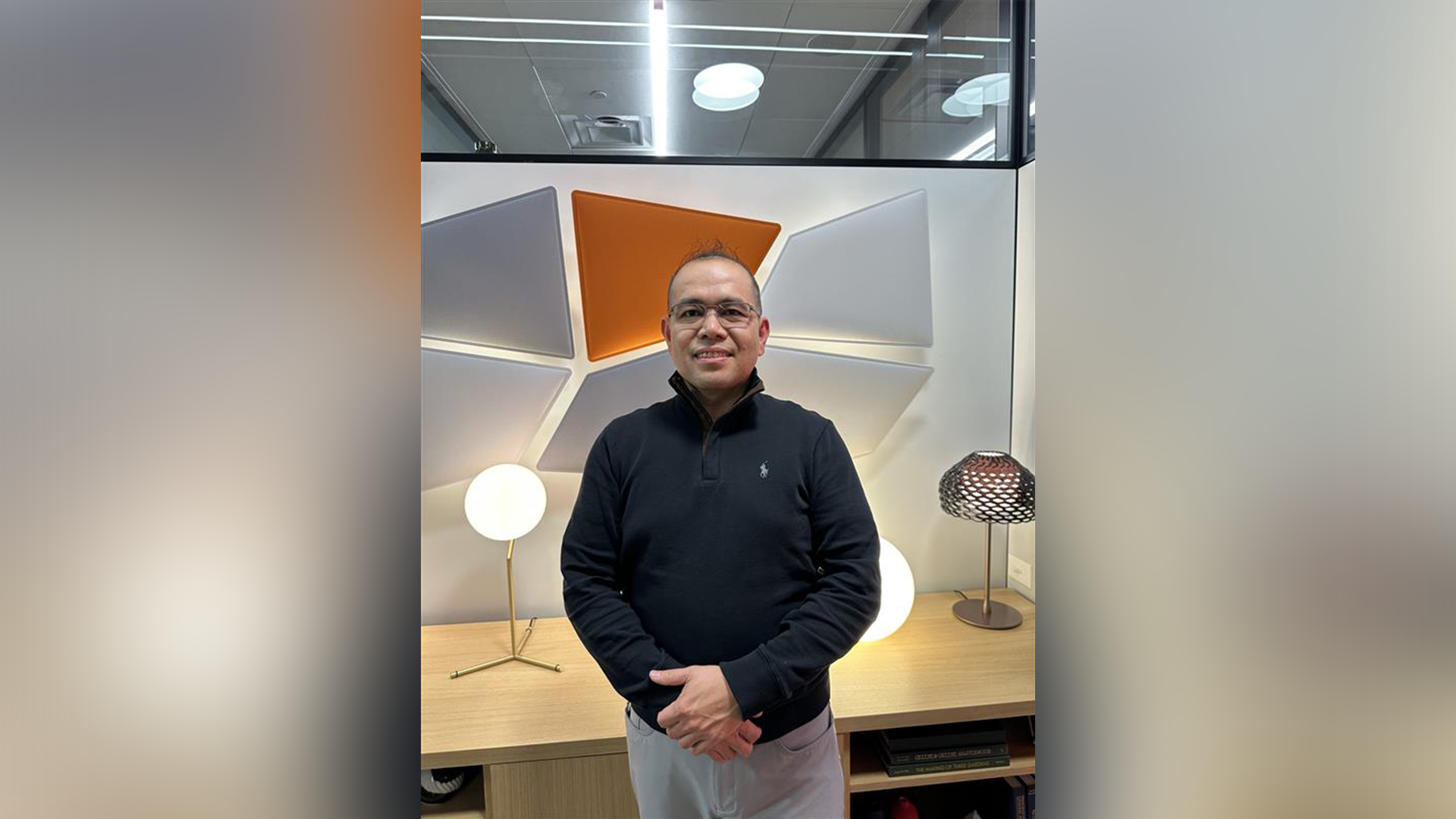How Much Technology Should Offices Really Be Adopting?

Written by Kelsi Maree Borland, GlobeSt.com Staff Writer
There are a lot of conversations about technology integration in office spaces, but rolling new technologies into a workspace can be challenging. Eric Lockwood, business development executive for the technology division of Tangram Interiors, says that ease of use and harmonized integration is crucial for successful integration. We sat down with him for an exclusive interview to find out how companies should be approaching technology integration and how they should develop a long-term strategy.
GlobeSt.com: Why is technology integration so important in today’s workspace?
Eric Lockwood: Innovative work environments should inspire people to excel, be the best they can be at what they do, and open their minds to think and work in new ways. Technology is an impactful driver for change, inspiration and ideation in the workspace. It is central to fostering engagement, igniting innovation and staying ahead of the competition in today’s fast economy. Workspace technology can promote improved and more natural communications, support mobility, enhance collaboration, untether users from fixed locations and wired connections, optimize resource utilization, attract and retain talent, and create a unique culture, identity and competitive differentiator for an organization. The implementation of workspace technology should synthesize and harmonize enabling audiovisual technologies with architectural design, furniture, lighting, acoustics, speech privacy, telecommunications networks, building automation systems, visitor management, access control, fire-life safety requirements and a host of other low-voltage building systems.
GlobeSt.com: What do you often companies do when beginning to approach technology integration?
Lockwood: Let’s face it, a lot of professionals in the technology integration business are gear heads. So when it comes to a discussion of technology in the workspace, many integrators immediately launch into a recital of product part numbers and specs. In 20 years as a technology consultant representing clients and architects, this is where I would stop the conversation and dial it back to first principles. The technology integrator’s first priority should always be to gain an insider’s understanding of the client—their business, culture, workflow, operations, technology support structure, growth drivers, vision for change and, importantly, the desired user experience as it pertains to any new technology implementations and integration within the space.
A default “go to” toward equipment vendors and part numbers is the happy place for many integrators but is entirely the wrong place to start. Those are potential solutions to problems, but it’s an understanding of the “problem” (opportunity) that needs to come first. That means focusing time on understanding how things are done now, what works and what doesn’t work, current pain points, and so on, as well as how and why things could be done differently from the perspective of the client’s operations, business objectives and vision.
This discovery process should at some point also include in-house personnel who deal with technology. Internal “techs” tend to have a unique and measured perspective of their user base wants and needs, and what it takes to support those needs efficiently and sustainably. As for the users themselves, they generally come from a very non-technical place, which is a good thing. They just want to be able to perform their work as efficiently, effectively, productively and enjoyably as possible, as well they should. To that end, user technology should be simple, intuitive and enabling. Period.
Keep in mind that since all organizations are different, and even within a single organization there are always numerous stakeholder groups with different priorities and personalities at the helm. There is never one right way of solving a problem. This is why leading with part numbers is a false start. All kinds of technology solutions, products and approaches are available, and the only constant is change.
The range of options for hardware solutions alone is dizzying, and increasingly there are software-based alternatives and hosted (cloud-based) solutions. Finding the appropriate mix to meet the client’s immediate and future needs, while harmonizing with the architectural vision, corporate culture and telecommunications environment, is key to a successful implementation as would be defined by the client.
GlobeSt.com: How should companies approach technology integration?
Lockwood: Follow the KISS Principle: Keep It Simple, Stupid. A significant challenge in today’s highly complex tech world is ease of use. This is an area where smart, user-oriented systems design and programming really differentiate excellence from mediocrity in a technology implementation. Setting aside architectural and environmental integration considerations for a moment, an audiovisual solution as a standalone system can be thought of as simply hardware and programming.
On the hardware side, the selection of physical equipment is generally determined by factors such as device capabilities and performance, interoperability (with mobile devices, digital networking protocols, software applications and legacy equipment, for example), technology standards and client vendor preferences, and of course physical parameters such as the size of a room, viewing distances and so on. With all of these valid considerations, making informed and strategic equipment choices is clearly a critical part of the process for delivering a fully functional and technically sound audiovisual solution.
GlobeSt.com: Once companies have chosen the appropriate technology, what is the next step to successfully to incorporate that technology into the workspace?
Lockwood: Arguably even more important than selecting the equipment is programming the equipment. Where many audiovisual integration firms under-deliver is in failing to invest the necessary time to appropriately configure and program each one of those pieces of equipment that comprise the system. Just about every single “box” in the system needs to first be configured to operate optimally and as intended, not to mention have its firmware updated and tested. Then, once the equipment is configured, the system as a whole needs to be strategically programmed in such a way that the resulting end-user experience is simple, intuitive and automated.
The interface between humans and technology is where the rubber meets the road and often where a system succeeds or fails. That human interface might be a signal connection point, a content sharing app on a mobile device, a touch screen control panel, a displayed image or any one of the many “edge devices” that bridge the electronic world with the physical world, such as cameras, loudspeakers, microphones and room sensors. Regardless of the interface, medium or transducer, simple and intuitive human interaction needs to be the primary design driver.
Engineering effective interfaces requires thinking as a user and caring about the user. The details matter (particularly to the end user), and every opportunity should be taken to not only include the client in decision making but to co-design the system and the experience with the client. That might mean presenting options for something as seemingly trivial as the labeling strategy for HDMI cables integrated into a conference table.
Or it might mean developing a full graphical user interface (GUI) mock-up for a touch panel or iPad control app so the client can experience it and steer the design on everything from basic aesthetics (like color schemes and icon types) to screen layouts, page navigation and system responsiveness (does the GUI provide the user with true visual feedback to verify control commands have been executed?).
GlobeSt.com: Why is it important to tailor the technology to the workspace?
Lockwood: Keep in mind it’s a lot easier to download “canned” generic programming templates from a vendor website, make a few minor adjustments to “customize” it and call it a day. The integrator that takes this path of least resistance invariably ends up delivering a system that has far too many unnecessary control options, far too much complexity and “noise” on the GUI pages, and far too much opportunity for the user to become confused and frustrated.
Unfortunately, this is the path often taken because the integrator has placed too much emphasis on initial equipment selection (and let’s face it, sales) and too little importance on user-centric system programming. The result is that the critical programming element is left to the very end and becomes a rushed effort as the client is moving into their space.
In addition, many integrators subcontract this programming effort to third-party programmers whose scope and availability is generally very limited. All of these factors conspire to make inadequate programming, which erodes system usability, a far too common occurrence in technology integration.
GlobeSt.com: Should companies have a long-term technology strategy?
Lockwood: For whatever myriad reasons, there is no good excuse for failing to plan the necessary time throughout the system development and implementation process to get system programming done right. The use of in-house programmers rather than outsourcing is strongly recommended as this allows the integrator to retain full ownership of the user experience from the preliminary storyboard to the beta version co-designed with the client to the final implementation, without any piece of that experience being lost in translation by a third-party programmer on a limited scope and schedule.
Likewise, there is no good excuse for not including the client in the decision-making and system development process. From the initial design concept all the way through to providing users with mock-up subsystems to test drive prior to installation, the concept of collaborative co-design with the client should remain central to the overall design ethos. The goal is that, by the time the system is installed and commissioned, it simply works and there are no surprises. The client walks in, sees the interface they helped design, knows how it works, and feels an immediate comfort level and ownership of it.
They say you’re only as good as your last performance. This holds true for technology integration. Poor planning that focuses too much on initial equipment selection, excludes client involvement from the design development effort and defers programming to the very end of the implementation process can make the very best, “state-of-the-art” equipment fail as a solution.
Originally Posted on GlobeSt.com














